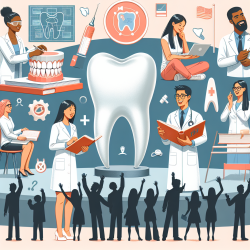Introduction
Dental therapy is gaining recognition as a crucial component of the dental profession in the United States, particularly in states like Alaska and Minnesota. However, the absence of nationally recognized educational standards has led to concerns about the uniformity of dental therapy education. The article "Recommended Standards for Dental Therapy Education Programs in the United States: A Summary of Critical Issues" addresses these concerns by proposing essential standards for dental therapy education. This blog will explore how practitioners can enhance their skills by implementing these standards or by conducting further research.
Key Recommendations from the Panel
The panel convened to address education standards focused on three critical issues: program length and degree, credentials of the program director, and the nature of supervision. These recommendations aim to provide a consistent framework for dental therapy education across the United States.
Program Length and Degree
The panel recommends a minimum of two years of full-time instruction at the post-secondary level, resulting in an associate degree for dental therapists. This standard allows community colleges to offer programs and encourages recruitment from underserved communities. The panel acknowledges that while a baccalaureate degree could enhance the profession's credibility, the two-year associate degree is a practical minimum standard.
Program Director Credentials
Given the nascent stage of dental therapy in the U.S., there is a limited pool of experienced dental therapists to direct programs. The panel recommends that a licensed dentist should be part of the program's leadership if the director is not a licensed dentist. This ensures that the program benefits from the expertise of a dentist while allowing flexibility in choosing qualified individuals for program administration.
Nature of Supervision
The panel emphasizes the importance of collaborative practice between dental therapists and dentists. While dental therapists should work under the supervision of a dentist, the standards are designed to foster a collaborative oral health team. This approach ensures that dental therapists can effectively contribute to patient care, especially in underserved areas where dentists and therapists may work in different locations.
Implementing the Standards
Practitioners can enhance their skills by integrating these standards into their educational programs. By aligning with these recommendations, institutions can ensure that their programs produce competent dental therapists ready to meet the needs of diverse communities. Additionally, practitioners should consider engaging in further research to refine these standards and adapt them to evolving healthcare needs.
Encouraging Further Research
While the panel's recommendations provide a solid foundation, ongoing research is crucial to address emerging challenges in dental therapy education. Practitioners are encouraged to explore areas such as:
- The impact of different educational models on student outcomes.
- Strategies for effective collaboration between dental therapists and other healthcare providers.
- Innovative approaches to recruit students from underserved communities.
Conclusion
The recommended standards for dental therapy education programs offer a pathway to standardize and enhance dental therapy education in the United States. By implementing these standards and engaging in further research, practitioners can contribute to the development of a robust dental therapy workforce capable of addressing the oral health needs of underserved populations.
To read the original research paper, please follow this link: Recommended standards for dental therapy education programs in the United States: a summary of critical issues.










